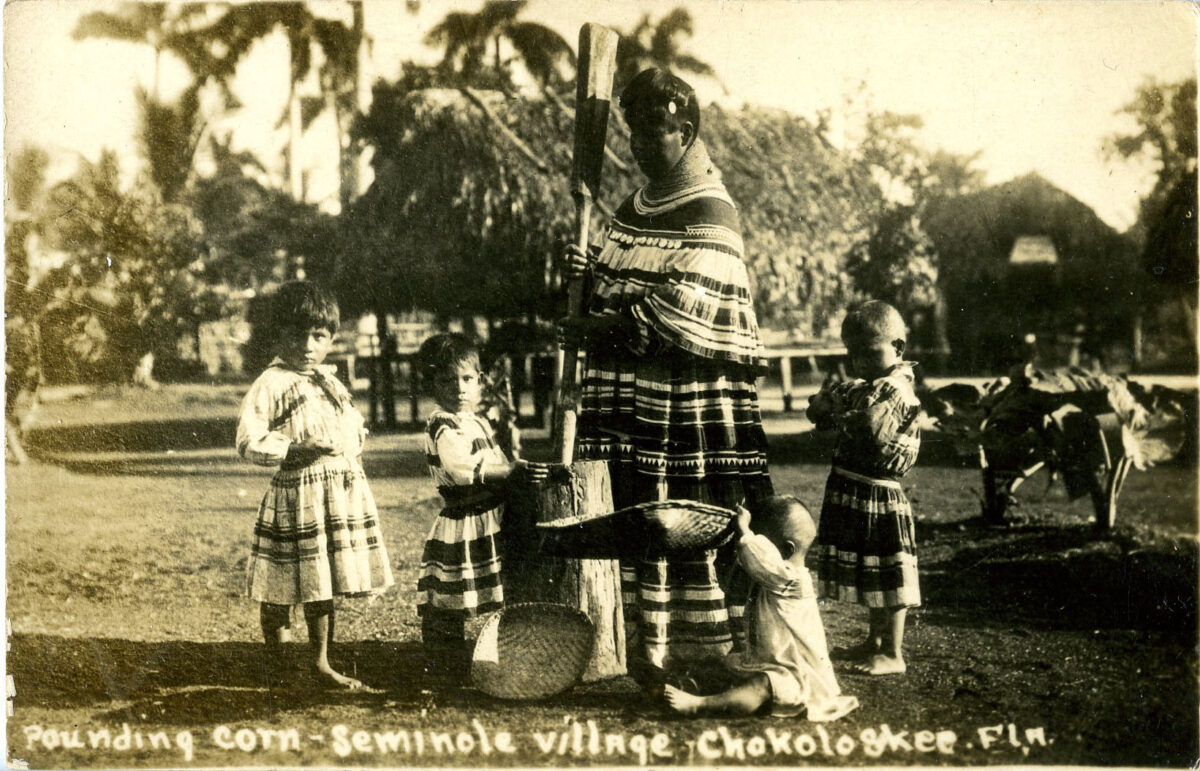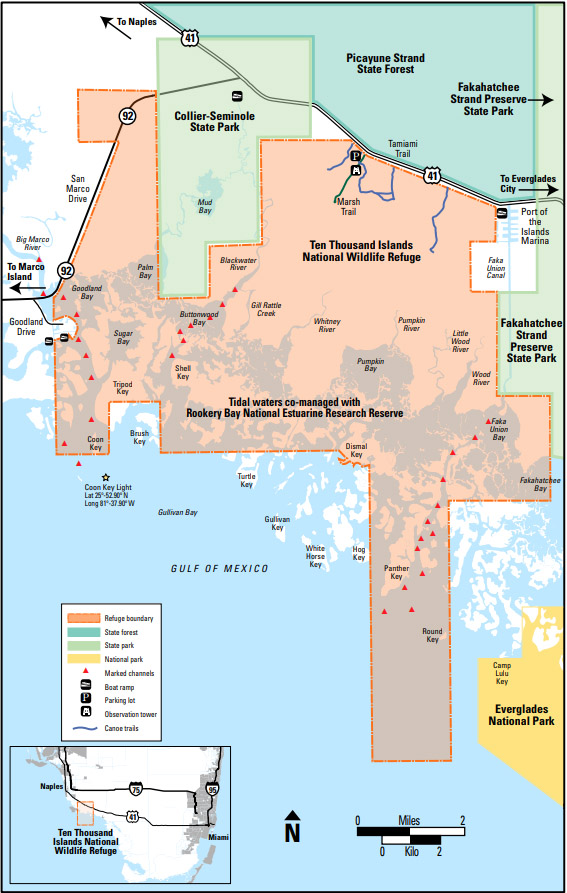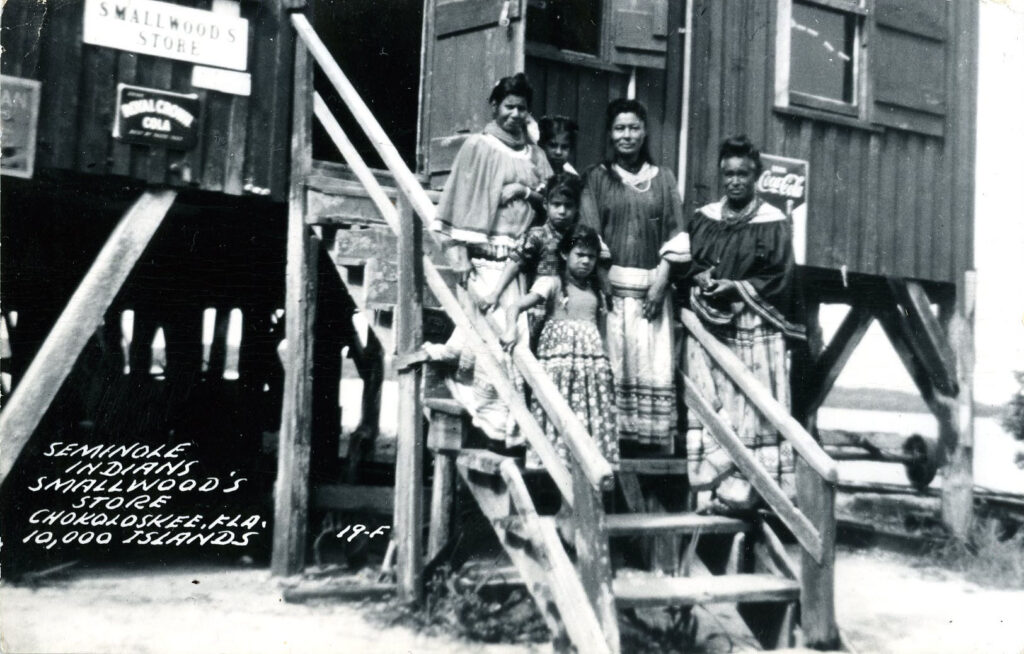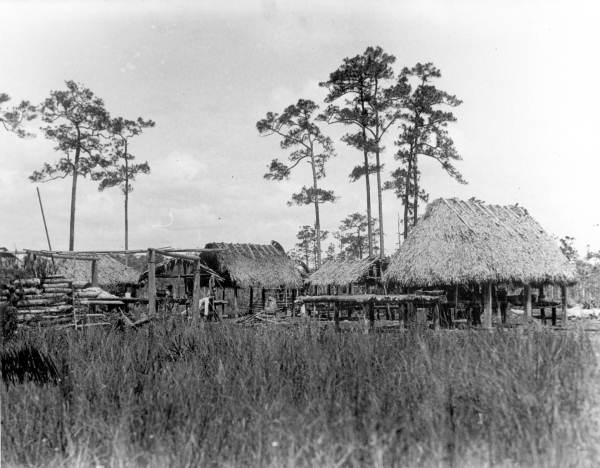
Seminole Spaces: The Ten Thousand Islands
Welcome back to the latest installment in our Seminole Spaces series! In this series, we explore places and spaces important to Seminole culture, history, and tourism. This week, we are looking at the remote and mysterious Ten Thousand Islands. Located deep in southwest Florida, this chain of islands and mangroves has long been home to Florida’s first people. But what do you know about this unique wildlife area? Join us to learn about the Ten Thousand Islands, from Seminole and Seminole ancestor history, to their important role in protecting some of Florida’s most precious natural resources.
In our featured image this week, you can see a Seminole woman in traditional clothing and hairstyle grinding corn at a Seminole camp outside Chokoloskee in the Ten Thousand Islands. You can also see two Seminole children beside her, as well as palmetto baskets. The image was reproduced as a postcard.
Are there really 10,000 islands?
So, are there really 10,000 islands? The short answer is no – although the islands are extensive, they number in the hundreds and not thousands. But, the area is constantly shifting as it consists of a vast network of mangroves, coastal high points, and other small keys.
Waterlogged yet magical, they contain shallow marine habitats that support a vast number of fish nurseries. Due to the shallow water, boating is a challenge for those who are not familiar with the location. Most of the islands are incredibly remote and isolated; the biggest island, Chokoloskee, only has a few hundred permanent residents. Compared to the other low-elevation islands, Chokoloskee clocks in at a dizzying 20-feet of elevation. This is due to the extensive occupation of the island over thousands of years, including prehistoric shell middens that artificially built up the elevation.
The Ten Thousand Islands National Wildlife Refuge is located to the northwest of Everglades National Park, just south of Marco Island. Both the refuge and Everglades National Park contain islands within the complex. The 35,000-acre refuge managed by the U.S. Fish and Wildlife Service was established in 1996. The refuge is home to several endangered and threatened species including the Florida manatee, bottlenose dolphins, peregrine falcon, wood stork, and green, loggerhead, and Kemp’s Ridley sea turtles. Over 200 migratory and endemic bird species call the refuge home, as well as nearly 200 fish species. Part of the greater Everglades ecosystem, this refuge protects mangrove, marsh, and tropical hardwood hammocks that provide habitats for several plant and animal species. In fact, the refuge encompasses the largest expanse of mangrove forest in North America.

Ten Thousand Islands Wildlife Refuge, and Everglades NP to the South. Via Wikimedia.
Seminole Ancestors in the Ten Thousand Islands
Seminole ancestors have lived in the abundance found in the Ten Thousand Islands for thousands of years. Prior to the Seminole Tribe of today, Seminole ancestor tribes occupied the islands, drawn by the rich, fertile soil and abundant fishing. The Calusa, who lived in the islands and controlled most of southwest Florida, were prominent until around the 1700s. They made first contact with Spanish conquistadors in 1513.
Strong sailors, the Calusa dug and constructed intricate canal ways for transportation throughout the region. Their dugout canoes were incredibly similar to historic Seminole dugout canoes, and were vital to their survival against smaller tribes and European conquerors. They lived in the interior waterways, and subsisted by fishing the numerous species in the area including mullet, pigfish, pinfish, and catfish. In the 1700s, disease and war splintered this highly sophisticated culture. Eventually, some would flee, and others would be folded into what would become the Seminoles.
Women and children collected shellfish like conchs, crabs, lobsters, clams, and oysters. One of the most complex and interesting remnants of the Calusa are the extensive shell mounds that were left behind. These shell mounds build up the elevation of many islands, and contain thousands of years of occupation history. In fact, shell mounds are prolific throughout southwest Florida, evidence of the complex and long-lasting Calusa occupation. Mound Key Archaeological State Park, just north in Estero, is one of the largest and believed to have been the cultural and ceremonial center for the Calusa. Built up entirely of clay and shell, it likely began as a mangrove-lined oyster bar barely breaching the surface of Estero Bay. Approximately 125 acres, the high point is 33 feet above sea level. The archaeological park is only accessible by boat, and visitors can hike from sunrise to sunset.
Seminole Villages, Trading Posts, and Trading in the Islands
In more recent history, Seminoles lived and traded extensively throughout the Ten Thousand Islands. In a previous Seminole Spaces post, we touched on the importance of trading posts in this era. Two that we discussed, Ted Smallwood’s Store on Chokoloskee and Storter’s at Everglade, were located within the Ten Thousand Islands complex. Smallwood’s Store was established in 1906, and “served a remote and isolated area buying hides, furs, and farm produce in exchange for providing the goods required to survive.” At the time, Seminoles still lived very remotely, cut off from many mainstream American influences.
Eventually, those like Charlie Tigertail would start their own Seminole-run trading posts. But, the connections made at the larger trading posts were instrumental in Seminole survival during this time. Incidentally, Charlie Tigertail and Ted Smallwood were good friends, Below, you can see a group of Seminole women and children standing on the steps of Ted Smallwood’s Store.

2001.75.2, ATTK Museum
Trading posts were important points of contact with non-Seminole traders. Seminoles would trade alligator hides, plumes, deer, foodstuffs, and eventually crafts and carved items. Around these trading posts, Seminoles would establish camps. Below, you can see a Seminole village in the Ten Thousand Islands near Chokoloskee circa 1915. Notably, the structures you can see are very similar to the modern chickees you may see today on the Seminole Reservations. These efficient, easily erected structures allowed Seminoles to quickly abandon them if necessary. They rose to prominence during the Seminole War period. As Seminoles began to lean more into tourism in the 20th century, even in the remote areas of the Ten Thousand Islands, they began to sell crafts and carvings, take postcard photos, and give demonstrations in their villages.

State Archives of Florida/Romer
The Importance of Canoes
Much like the Calusa, Seminoles in this area were incredibly dependent on the use of dugout canoes to navigate the complex waterways of the Ten Thousand Islands. Historic Seminole canoes were made of dugout cypress logs, and perfect for the incredibly shallow waters of the islands. They could be as long as 15 feet, and carry an entire family. Not just for transportation, they were vital for carrying trade goods to the non-Seminole trading posts, as well as fishing and hunting from the water. Although water does not connect South Florida as much as it did hundreds of years ago, canoes are still an important cultural touchstone for the Seminoles.

2015.6.28156, ATTK Museum
Above, you can see an image of Mercedes Osceola, daughter of Joe Dan and Virginia Osceola, sitting in a dugout canoe on March 5, 2000. Mercedes waves and is wearing a crown and sash that designate her as “Junior Miss Seminole,” one of the Seminole pageant titles. For an event, Osceola was poled in a dugout canoe across Chokoloskee Bay to Ted Smallwood’s Store. Although we don’t know exactly what event precipitated the display, it highlights the importance even now of canoes around the Ten Thousand Islands.
Visiting the Ten Thousand Islands Today
Are you looking to visit the Ten Thousand Islands? While remote and isolated, there are several opportunities to explore this seemingly untouched part of Florida’s natural beauty. Chokoloskee Island supports a robust recreational fishing trade, and there are regularly scheduled eco-tours available on the island. Ted Smallwood’s Store on Chokoloskee is now a historic site. The location includes a small museum about Seminole trading and early Florida pioneers. There are a number of marked and well-used kayak and canoe trails within the Ten Thousand Islands for seasoned paddlers. Part of the Ten Thousand Islands extends down to Everglades National Park, including a canoe trail to Sandfly Island. If you don’t want to explore on your own steam, there are guided and narrated boat tours available through the Gulf Coast Visitor’s Center in Everglades National Park.
Interested in learning more about Calusa shell middens? Mound Key Archaeological State Park and the Mound House slightly further north are great options. Mound House, on Fort Myers Beach, offers kayak tours, guided hiking tours, interactive educational exhibits, and even a peek into the shell mound.
Additional Sources
The author accessed these sources digitally. Page reference numbers may not align with paper and hardback copies.
West, Patsy. The Enduring Seminoles: From Alligator Wresting to Casino Gaming, Revised and Expanded Edition. 2008. University Press of Florida. Digital.
Author Bio
Originally from Washington state, Deanna Butler received her BA in Archaeological Sciences from the University of Washington in 2014. Deanna moved to South Florida in 2016. Soon, she began working for the Seminole Tribe of Florida’s Tribal Historic Preservation Office. Deanna was the THPO’s Archaeological Collections Assistant from 2017-2021. While at the THPO, Deanna worked to preserve, support, and process the Tribe’s archaeological collection. She often wrote the popular Artifact of the Month series, and worked on many community and educational outreach programs. She lives in Fort Myers, FL with her husband, son, and dog.



